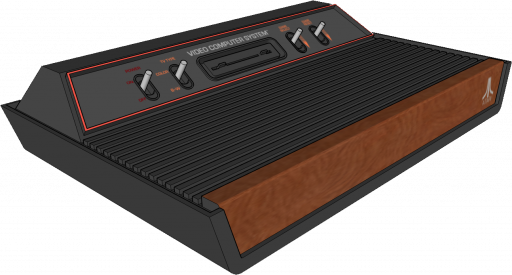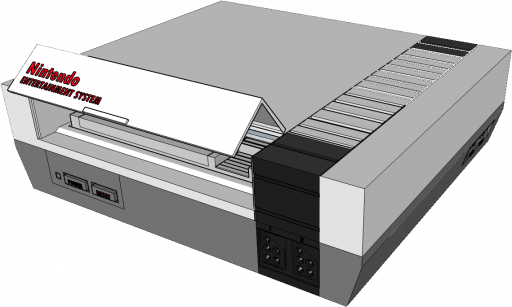This post is a copy of the background information that I provided for my recent exhibit at the Pensacola Mini Maker Faire to establish the historical relevance of my work with the Atari VCS and Nintendo NES consoles. If you have already know quite a lot about these systems, there will probably not be much here for you, but I’m keeping it around for reference.
Enjoy!
Introduction

The MOS 6502 sparked a revolution in the computing world in 1975 and eventually brought us some of the first and most influential personal computers with the likes of the Apple IIe, Commodore 64, and BBC Micro. While hobbyists and tech companies were taking notice of the power and affordability of this new microprocessor, the arcade industry was in full effect and many arcade enthusiasts dreamed of being able to master their arcade favorites in the luxury of their own home… without spending precious quarters, of course.
Atari VCS/2600
It didn’t take long for arcade developer and manufacturer Atari to take notice and release the Atari Video Computer System in 1977 (VCS for short and later known as the 2600). This modest home console’s technical specifications were only designed to play two games, Pong and Combat, but because of its cartridge format, flexible architecture, and software/hardware relationship, programmers were able to develop games to the likes of Pitfall which far exceeded the hardware’s expectations. Continual software ingenuity and creativity extended the lifespan of the VCS for 15 years until it was finally discontinued in 1992.

Nintendo NES
After the video game crash of 1983 caused by the market saturation of poor third-party titles, consumer’s trust in the video game market began to fall, but the desire to play must have never left. Because Nintendo released their first home video game console, the Famicom (known as the Nintendo Entertainment System or NES in the US), in 1983 based on the same 6502 processor released 8 years prior. Though the VCS and the Famicom used the same processor, Nintendo’s console offered far superior power by packing in a capable video processor (known as the PPU, Picture Processing Unit), 16 times more RAM, dedicated video RAM, and the ability to access much more cartridge ROM. These specifications along with additional features added within each cartridge allowed for far superior games to be made that run on the same processor core. Some notable titles which use the NES/Famicom to its fullest potential include Super Mario Bros 3, The Legend of Zelda, and Kirby’s Adventure. This console single-handedly brought the video game industry back to life after its sudden decline by inspiring consumers with the quality of each cartridge.

Current Use
The 6502 was so influential that to this day they are still being produced and used (mostly in industrial applications) by Western Design Center (WDC), the latest version being the W65C02S-14. Nowadays, there are many modern tools out there to continue homebrew development for both the VCS and the NES and a whole new community and industry has risen around the release of new games for both systems.

Maker Faire Exhibit
In the spirit of these two consoles, I have being working on developing games for both that run on software emulators and actual hardware. Doing this requires extensive programming in 6502 assembly, creating the hardware and software tools to write game cartridge EEPROMs, and assembling the final cartridges. The two games that I am developing and will be showing off are Spider Web for the VCS and Ogre Cave Climb for the NES. I will demonstrate the methods to program these games and how the final cartridges are made as well as have each console set up to allow visitors to try it out for themselves.
External Links
- Spider Web for the Atari VCS: https://github.com/dcooperdalrymple/vcs-spider
- Ogre Cave Climb for the Nintendo Entertainment System: https://github.com/dcooperdalrymple/nes-ogre